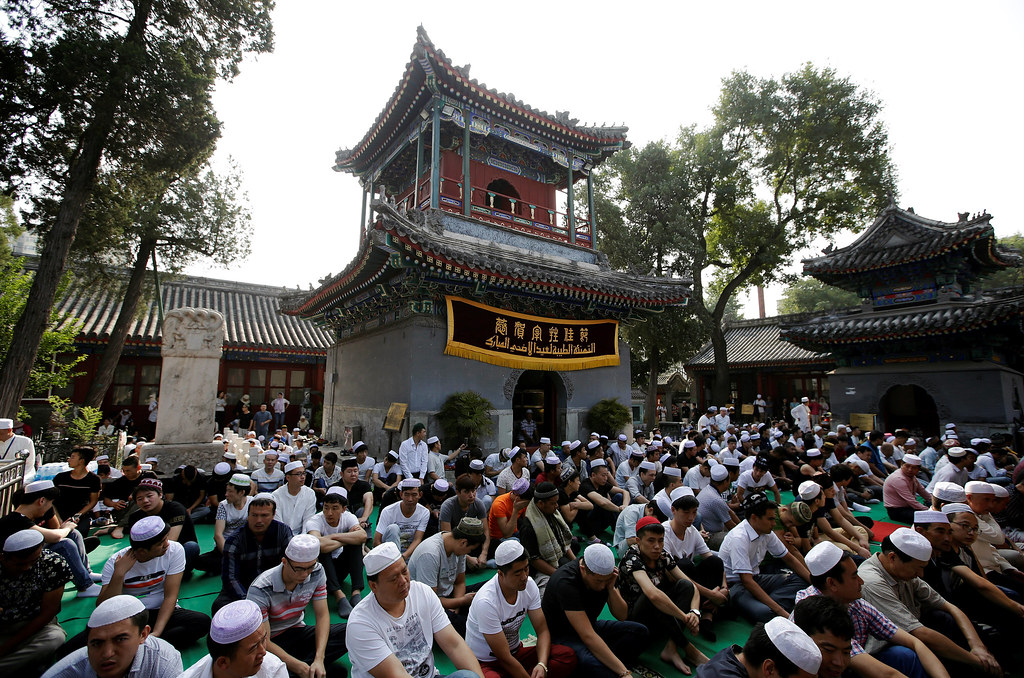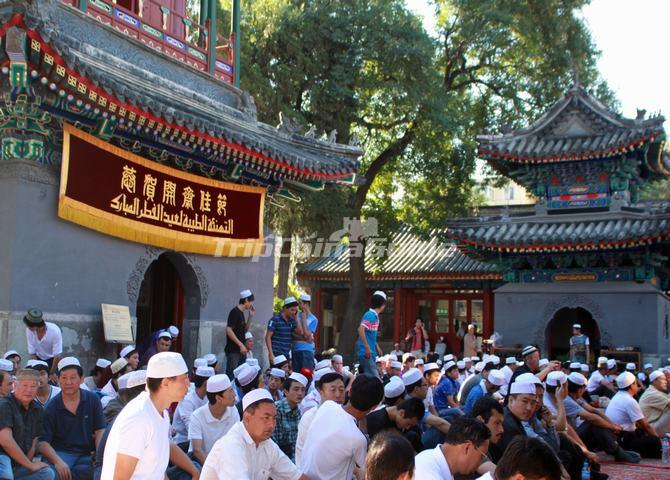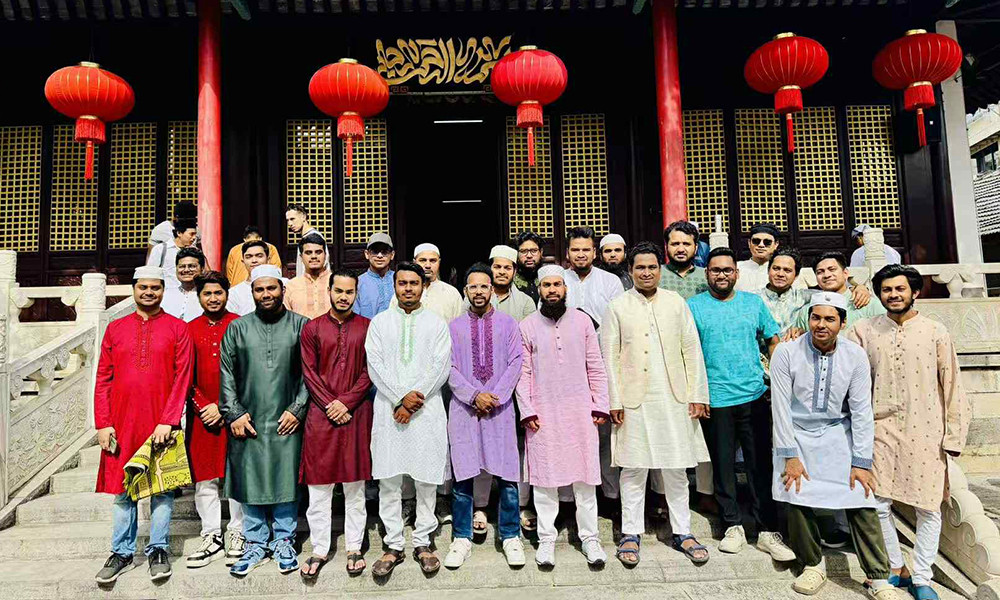Print: 29 Oct 2025
Eid-ul-Azha, one of the two most significant Islamic festivals, is being observed by millions of Muslims across the globe — and China is no exception. Despite their relatively small population, Chinese Muslims celebrate the occasion with deep devotion and enthusiasm.
While the spirit of Eid remains the same, the ways it is observed vary across China’s vast regions. The majority of Chinese Muslims reside in provinces such as Ningxia, Gansu, and Qinghai, home primarily to the Hui and Uighur ethnic groups — two of the ten predominantly Sunni Muslim communities among China’s 55 official ethnic minorities.
As the Muslim community in China prepares to celebrate Eid-ul-Azha on Friday, (June 6) millions are gathering to honor the traditions of faith, sacrifice, and unity.

From the Hui neighborhoods of Ningxia and Gansu to the Uighur heartlands of Xinjiang, the festival is a vibrant blend of religious devotion and cultural heritage, showcasing the diverse and enduring identity of Islam in China.
According to Wikipedia, China is home to an estimated 20–30 million Muslims, comprising less than 2 percent of the total population. Hui Muslims are the most numerous group nationwide.
The greatest concentration of Muslims resides in northwestern China's Xinjiang autonomous region, which has a significant Uyghur population.
This geographic and cultural diversity influences how Eid is celebrated across different communities.
The Muslim population in Beijing (the capital of China) is smaller compared to many other provinces. Muslims in the city also celebrate Eid with a festive mood. The day begins with prayers held in mosques nationwide.

It may be mentioned that before attending the Eid prayers, the participants have to do pre-registration. Without registration for the relevant mosque, the participants can not entre the mosque. The government of China introduces this system to maintain smooth and hassle free Eid prayers.
Speaking to the Daily Sun, Md. Main Uddin, a Bangladeshi PhD student at Nanjing University of Information Science and Technology, said, “We Bangladeshis usually offer Eid prayers at the Eidgah, but Chinese Muslims perform their Eid prayers at mosques instead. Everyone is required to register in advance to attend the Eid prayers at their respective mosques.”
Main Uddin also said, “In Nanjing, Muslims gather for Eid prayers between 7:30 and 8:00 a.m. Prior to the prayers, the national flag is hoisted and the national anthem is sung — a gesture reflecting both patriotism and unity. On the occasion, heightened security measures are put in place around mosque premises to ensure a safe and orderly celebration.”
“Eid day is not considered a public holiday for Muslims here. As a student, I often attend classes and labs even on Eid,” he added.

Speaking to the Daily Sun, one of the Bangladeshi students named Ashraful Kabir in Qingdao City, said that they usually offer the Eid-ul-Azha prayers at 8:00 am.
He said, “I have been living in China for two years. I’m studying at the China University of Petroleum (CUP). Muslim population in this country very small. But we try to celebrate in a befitting manner. This is the fourth Eid of my life that I’m spending without my family. In the morning, I wore a traditional panjabi and went to attend the Eid prayers. It felt really good to see Muslims from India, Pakistan, and Bangladesh gathered together there. After the prayers, we exchanged greetings and spent time chatting with friends.
“These special Eid prayer sessions often draw large congregations, with sermons emphasising themes of sacrifice, gratitude, and unity. For many Muslims, the prayer is an opportunity to reaffirm faith and seek blessings for their families and communities,” he said.
He said after offering prayer, they slaughter sacrificial animals, hoping to receive blessings from the Almighty Allah.
The Daily Sun Reporter spoke to a Chinese man living in Beijing named Sasha Alex. He said there are about 65 mosques in Beijing and one can offer prayers at any of them without restrictions or hassles.
The Niujie Mosque, which is the oldest in Beijing, covers an area of approximately 10,000 square metres. Its main prayer hall is 600 square metres and can accommodate more than 1,000 worshippers.
“Niujie is a famous Muslim community known for its halal food, attracting both Muslims and non-Muslims who come to enjoy its vibrant street cuisine,” he said.
In Beijing, there are also some designated places where Muslims slaughter their sacrificial animals.
Those who do not slaughter animals often celebrate by visiting restaurants to enjoy festive meals. In Beijing, several Indian and Bangladeshi restaurants offer special Eid-ul-Azha buffet lunches and dinners featuring Qurbani beef or mutton.
Many communities organise cultural performances, music and folk dances that highlight their unique heritage.
Markets and street stalls come alive with vendors selling festive foods, traditional attire and religious artefacts, creating vibrant scenes of celebration.
Eid in China is a reflection of the resilience and cultural identity of Chinese Muslim communities.
It serves as a time to reinforce faith, celebrate cultural traditions and strengthen communal bonds amid a diverse societal landscape.
Eid in China: A glimpse into Muslim festivities across the nation

Photo : Daily Sun
Eid-ul-Azha, one of the two most significant Islamic festivals, is being observed by millions of Muslims across the globe — and China is no exception. Despite their relatively small population, Chinese Muslims celebrate the occasion with deep devotion and enthusiasm.
While the spirit of Eid remains the same, the ways it is observed vary across China’s vast regions. The majority of Chinese Muslims reside in provinces such as Ningxia, Gansu, and Qinghai, home primarily to the Hui and Uighur ethnic groups — two of the ten predominantly Sunni Muslim communities among China’s 55 official ethnic minorities.
As the Muslim community in China prepares to celebrate Eid-ul-Azha on Friday, (June 6) millions are gathering to honor the traditions of faith, sacrifice, and unity.

From the Hui neighborhoods of Ningxia and Gansu to the Uighur heartlands of Xinjiang, the festival is a vibrant blend of religious devotion and cultural heritage, showcasing the diverse and enduring identity of Islam in China.
According to Wikipedia, China is home to an estimated 20–30 million Muslims, comprising less than 2 percent of the total population. Hui Muslims are the most numerous group nationwide.
The greatest concentration of Muslims resides in northwestern China's Xinjiang autonomous region, which has a significant Uyghur population.
This geographic and cultural diversity influences how Eid is celebrated across different communities.
The Muslim population in Beijing (the capital of China) is smaller compared to many other provinces. Muslims in the city also celebrate Eid with a festive mood. The day begins with prayers held in mosques nationwide.

It may be mentioned that before attending the Eid prayers, the participants have to do pre-registration. Without registration for the relevant mosque, the participants can not entre the mosque. The government of China introduces this system to maintain smooth and hassle free Eid prayers.
Speaking to the Daily Sun, Md. Main Uddin, a Bangladeshi PhD student at Nanjing University of Information Science and Technology, said, “We Bangladeshis usually offer Eid prayers at the Eidgah, but Chinese Muslims perform their Eid prayers at mosques instead. Everyone is required to register in advance to attend the Eid prayers at their respective mosques.”
Main Uddin also said, “In Nanjing, Muslims gather for Eid prayers between 7:30 and 8:00 a.m. Prior to the prayers, the national flag is hoisted and the national anthem is sung — a gesture reflecting both patriotism and unity. On the occasion, heightened security measures are put in place around mosque premises to ensure a safe and orderly celebration.”
“Eid day is not considered a public holiday for Muslims here. As a student, I often attend classes and labs even on Eid,” he added.

Speaking to the Daily Sun, one of the Bangladeshi students named Ashraful Kabir in Qingdao City, said that they usually offer the Eid-ul-Azha prayers at 8:00 am.
He said, “I have been living in China for two years. I’m studying at the China University of Petroleum (CUP). Muslim population in this country very small. But we try to celebrate in a befitting manner. This is the fourth Eid of my life that I’m spending without my family. In the morning, I wore a traditional panjabi and went to attend the Eid prayers. It felt really good to see Muslims from India, Pakistan, and Bangladesh gathered together there. After the prayers, we exchanged greetings and spent time chatting with friends.
“These special Eid prayer sessions often draw large congregations, with sermons emphasising themes of sacrifice, gratitude, and unity. For many Muslims, the prayer is an opportunity to reaffirm faith and seek blessings for their families and communities,” he said.
He said after offering prayer, they slaughter sacrificial animals, hoping to receive blessings from the Almighty Allah.
The Daily Sun Reporter spoke to a Chinese man living in Beijing named Sasha Alex. He said there are about 65 mosques in Beijing and one can offer prayers at any of them without restrictions or hassles.
The Niujie Mosque, which is the oldest in Beijing, covers an area of approximately 10,000 square metres. Its main prayer hall is 600 square metres and can accommodate more than 1,000 worshippers.
“Niujie is a famous Muslim community known for its halal food, attracting both Muslims and non-Muslims who come to enjoy its vibrant street cuisine,” he said.
In Beijing, there are also some designated places where Muslims slaughter their sacrificial animals.
Those who do not slaughter animals often celebrate by visiting restaurants to enjoy festive meals. In Beijing, several Indian and Bangladeshi restaurants offer special Eid-ul-Azha buffet lunches and dinners featuring Qurbani beef or mutton.
Many communities organise cultural performances, music and folk dances that highlight their unique heritage.
Markets and street stalls come alive with vendors selling festive foods, traditional attire and religious artefacts, creating vibrant scenes of celebration.
Eid in China is a reflection of the resilience and cultural identity of Chinese Muslim communities.
It serves as a time to reinforce faith, celebrate cultural traditions and strengthen communal bonds amid a diverse societal landscape.






